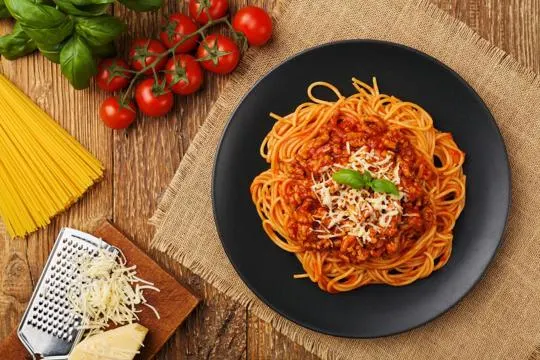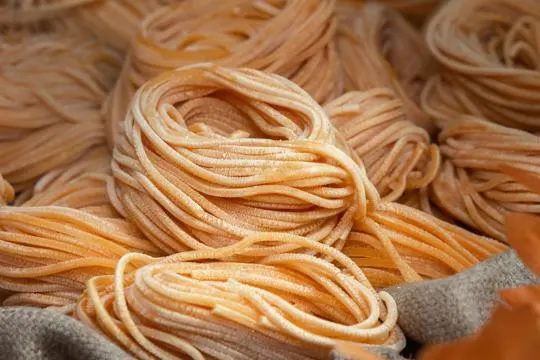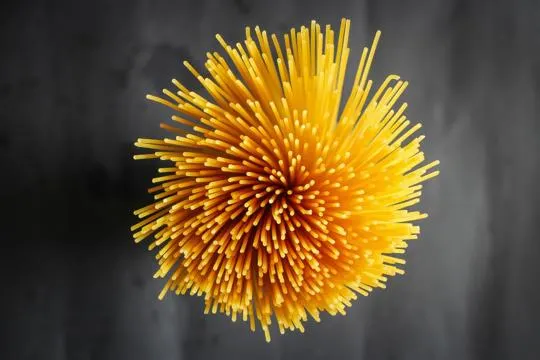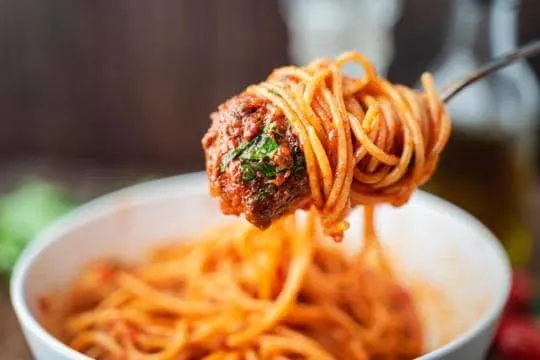Summary of key points
The main difference between spaghetti and linguini is the shape and thickness of the pasta. Spaghetti is long, thin, and round while linguini is flat and wider.
In terms of taste, both types of pasta have a similar flavor since they are made from the same ingredients (semolina flour and water). The difference in texture may affect how sauces cling to the pasta, with linguini being able to hold onto thicker and chunkier sauces better.
Additionally, due to its wider shape, linguini may have a chewier texture compared to spaghetti. This can also affect cooking time, with linguini typically taking longer to cook than spaghetti.
In terms of culinary uses, both pastas can be used in a variety of dishes but are often paired with different types of sauces and toppings. Spaghetti is commonly used in dishes with tomato or meat-based sauces while linguini is often used in seafood or cream-based sauces.
Spaghetti and Linguini. Two pastas that seem almost identical, right? Not quite.
We’ve all been there at the dinner table, fork in hand, staring down a plate of pasta, pondering life’s big questions. What is the real deal between these two?
I remember my first spaghetti disaster. Sauce everywhere but the pasta. Linguini, however, was a smoother sail.
These noodles hail from the same family but carry distinct characteristics. Spaghetti’s round. Linguini’s flat. That simple difference influences the sauce cling factor.
In our kitchens, we’ve argued, experimented, and even swapped them to see if anyone would notice. Spoiler: they did.
Understanding these nuances can elevate a meal from good to unforgettable.
What is Spaghetti?

Spaghetti: a classic Italian pasta dish that has won the hearts and taste buds of people all over the world.
Its long, slender noodles are made from durum wheat semolina, giving them a firm texture when cooked.
This pasta comes in different thicknesses, with thinner ones great for lighter sauces, and thicker for heartier toppings.
What makes spaghetti so special? Its ability to pair with any sauce.
From Bolognese to marinara, it provides a delicious base that complements any flavor.
Plus, its long shape is perfect for capturing sauce in every bite.
Spaghetti has cultural significance too. Its origins date back to ancient Italy.
Over time, it has become a staple in households all over the globe, and a symbol of Italian cuisine abroad.
So next time you’re craving a comforting bowl of pasta, reach for spaghetti.
With its delightful chewiness and flavor-enhancing powers, it will continue to be loved by food enthusiasts worldwide.
Enjoy it al dente, or softened to your liking.
Either way, spaghetti will satisfy your cravings for an authentic Italian dining experience.
What is Linguini?

Linguini is a traditional Italian pasta. It has a long, flat shape like a ribbon.
Made from wheat semolina and water, it’s tender yet slightly firm when cooked al dente.
It can be paired with various sauces, from light to rich.
Linguini’s smooth surface helps hold on to sauces, giving each bite flavor.
It also has a wide surface area, for a pleasant mouthfeel.
Enjoy it with a tomato sauce or with seafood in a creamy garlic sauce.
Linguini offers a delicious experience each time.
Differences Between Spaghetti and Linguini

Spaghetti and linguini are both great, but they are unique.
Knowing the differences helps you choose which pasta to go with.
It depends on the sauce and your desired experience.
Shape and Size
Ever questioned the difference between spaghetti and linguini? It lies in their shapes and sizes.
Spaghetti is thin and cylindrical, like a rod. Whereas linguini is flat and ribbon-like.
This influences their texture and ability to hold sauce.
Spaghetti’s cylindrical shape lets it bind with sauces well.
It’s perfect for dishes like spaghetti aglio e olio or carbonara.
Its smoothness allows sauces to coat each strand.
Plus, the thickness makes it strong, preventing it from becoming limp or mushy when cooked.
Linguini’s flatness offers a different dining experience.
The surface area allows more sauce coverage.
Its wider width gives a chewier texture when cooked aldente, making it enjoyable.
Both pasta shapes have their own charm, yet cater to different sauces and culinary styles.
Thicker sauces go better with spaghetti, as they can coat each strand.
Lighter sauces like olive oil-based dressings or seafood-based sauces suit linguini’s flatness.
Origin and Traditional Use
Spaghetti and linguini have distinct origins.
Spaghetti comes from Italy, with its long, thin cylindrical shape.
It’s perfect for spaghetti bolognese and carbonara.
Linguini hails from the Liguria region of Italy and is flat and narrow.
It’s best served with seafood sauces like clam sauce or pesto Genovese.
Spaghetti’s round shape gives a good sauce distribution.
Whilst linguini’s flat shape holds onto heartier sauces nicely.
These pasta types can be adapted to other cuisines.
And they make great twirling and slurping food. Enjoy them with olive oil or ragùs.
In conclusion, spaghetti and linguini offer unique attributes.
Spaghetti’s thin shape suits many sauces.
Whilst linguini’s flatness pairs well with seafood-based sauces.
They both provide endless possibilities in the kitchen, and are loved by foodies around the world.
Sauce Pairings
When it comes to pasta and sauce combos, there are certain pairings that bring out the best flavors.
Spaghetti and linguini are two popular types. Spaghetti is long and thin.
It goes well with hearty, chunky sauces like marinara and Bolognese.
Its texture lets it cling onto the sauce.
Plus, spaghetti is great with lighter herb-infused sauces too.
Linguini is wider and flatter. It’s best suited for creamy sauces or oil-based dressings.
Alfredo sauce is a great match. Olive oil-based sauces with garlic and chili flakes also work well.
Linguini has another unique quality: it’s great with seafood sauces.
Its wide surface area’s perfect for delicate seafood flavors.
Try a lemon-butter sauce with shrimp or scallops – it’s refreshing and delicious.
Texture and Mouthfeel
Texture and mouthfeel are two things to consider when comparing spaghetti and linguini.
Spaghetti is long and thin, with a firm and chewy texture.
Sauces stick to each strand which creates a great flavor mix.
Mouthfeel adds to the overall dining experience.
Linguini is flat and narrow, providing a delicate texture.
Its wide surface absorbs sauces better, creating a more homogenous flavor.
The tender mouthfeel of linguini makes it luxurious.
Both spaghetti and linguini provide unique textural experiences that cater to different preferences.
Enjoy hearty spaghetti or tender linguini for a great meal.
Similarities Between Spaghetti and Linguini

Spaghetti and linguini are two Italian pasta types with many similarities.
They both use flour and water/eggs, which give them a unique texture and taste.
Both can be cooked al dente or soft. Plus, they have similar sauces and ingredients.
For instance, marinara or bolognese for tomato-based sauces, and Alfredo or carbonara for creamy sauces.
Seafood dishes like spaghetti vongole or clam linguini also go well with either type of pasta.
Cooking techniques for spaghetti and linguini are similar.
Boil them in salted water until they reach the desired tenderness.
This ensures the shape is preserved but they are cooked through.
However, each type has unique features.
Spaghetti is versatile and good for all sorts of flavors.
Its round shape helps it hold onto thick sauces.
Whereas, linguini is flat and wider than spaghetti.
Thus, it can better deal with chunky sauces and ingredients.
Cooking and Serving Tips for Spaghetti and Linguini
Cooking and serving spaghetti and linguini require different techniques.
Here’s a guide to help you master the art of preparing these pastas.
Choose the right one: Select a spaghetti or linguini that suits your preference.
Spaghetti is long and thin; linguini is wider and flat.
Cook al dente: Cook both al dente.
Follow the package cooking time, but taste-test to ensure they’re not overcooked.
Pair with sauces: Spaghetti’s shape makes it great for marinara or Bolognese.
Linguini works well with lighter sauces such as pesto or clam sauce.
Serve it right: Serve spaghetti in a neat nest-like shape.
Gently toss linguini with sauce before transferring to dishes.
Add garnishes: Consider herbs or grated cheese as garnish.
Explore flavor combinations for each type of pasta.
Differences: Note that spaghetti is more commonly used in Italian cuisine, while linguini is from Ligurian cuisine.
Create meals: Mastering both will enable you to create delicious Italian-inspired meals.
Experiment with recipes to find your favorites.
Conclusion
In the end, the debate over which pasta is superior will never be solved.
Each offers their own unique benefits and drawbacks; it all comes down to personal preference.
However, one thing is certain – whether you prefer spaghetti or linguine, a delicious bowl of pasta can always put a smile on any face.
There are countless recipes available online and in cookbooks covering both pastas; we all can find something that matches our individual tastes no matter what type of pasta we may choose.
The simple ingredients of calamari, spaghetti, or linguine combined with fragrant garlic and herbs make for tasty Italian dishes that will have family and friends clamoring for seconds.
So let the debate between spaghetti and linguine continue – but let us enjoy every bite along the way.

Leave a comment